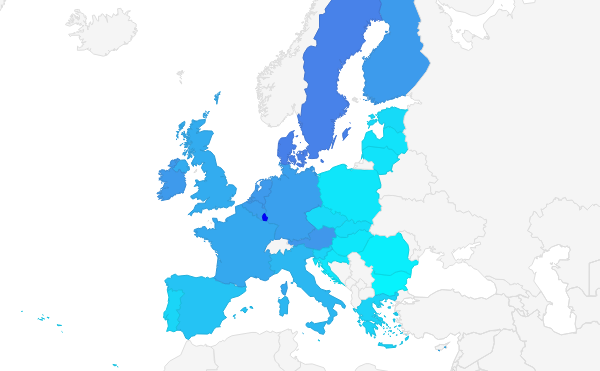Back in 2013, the European Union (EU) was a political and economic union of 28 member states that were located primarily in Europe.
While the European Union consists of 28 member states. Some would say - Europe is United. Is it so? Let's figure out, who lives better and who does not.
Update: GDP Per Capita in European Union 2022
GDP per Capita in European Union 2013
| 2012 | 2013 | Change $ | Growth % | |
| Luxembourg | 103859 | 111162 | 7303 | 6.56 |
| Denmark | 56364 | 58930 | 2566 | 4.35 |
| Sweden | 55039 | 58164 | 3125 | 5.31 |
| Austria | 46792 | 49074 | 2282 | 4.65 |
| Netherlands | 45961 | 47617 | 1656 | 3.47 |
| Ireland | 45922 | 47400 | 1478 | 3.11 |
| Finland | 45649 | 47219 | 1570 | 3.32 |
| Belgium | 43396 | 45387 | 1991 | 4.38 |
| Germany | 42598 | 45085 | 2487 | 5.51 |
| France | 39759 | 41421 | 1662 | 4.01 |
| United Kingdom | 38649 | 39351 | 702 | 1.78 |
| Italy | 33814 | 34619 | 805 | 2.3 |
| Spain | 28282 | 29118 | 836 | 2.87 |
| Cyprus | 26352 | 24928 | -1424 | -5.71 |
| Greece | 22395 | 21910 | -485 | -2.21 |
| Slovenia | 22059 | 21816 | -243 | -1.11 |
| Malta | 20839 | 21339 | 500 | 2.34 |
| Portugal | 20175 | 21029 | 854 | 4.06 |
| Czech Republic | 18690 | 18861 | 171 | 0.90 |
| Estonia | 16887 | 18478 | 1591 | 8.61 |
| Slovakia | 16893 | 17045 | 152 | 0.89 |
| Lithuania | 14172 | 14688 | 516 | 3.5 |
| Latvia | 13947 | 14588 | 641 | 4.39 |
| Croatia | 13159 | 13530 | 371 | 2.74 |
| Poland | 12721 | 13432 | 711 | 5.29 |
| Hungary | 12560 | 12698 | 138 | 1.08 |
| Romania | 8437 | 9499 | 1062 | 11.18 |
| Bulgaria | 7022 | 7296 | 274 | 3.75 |
| Average | 31156.85714 | 32345.85714 | 1189 | 3.67 |
As we can see from Table above, GDP per capita has increased in almost every EU member state, with except - Cyprus (-5.7%), Greece (-2.2%) and Slovenia (-1.1%).
In overall GDP per capita in European union has raised by average 3.6% and totals in $32.345 thousands per capita.
By now I would like to divide this table in smaller units, those who receive the most and those who receive less.
- Lets take average GDP per capita in EU and divide those who are above and those who are bellow.
- In total 12 European economies has GDP per capita higher than average median in whole EU - Luxembourg, Denmark, Sweden, Austria, Netherlands, Ireland, Finland, Belgium, Germany, France, United Kingdom and Italy.
- The rest of member countries are bellow average median GDP per capita in EU in 2013.
I would like to Make another table dividing European states in groups:
| Country | Population | % of Population | ||
| > 50 thousands | Luxembourg, Denmark, Sweden | 15.6 | 3.05% | |
| 40-50 thousands | Austria, Netherlands, Ireland, Finland,Belgium, Germany, France | 193.9 | 38.02% | |
| 30-40 thousands | United Kingdom, Italy | 124.1 | 24.33% | |
| 20-30 thousands | Spain, Cyprus, Greece, Slovenia, Malta, Portugal | 72.7 | 14.25% | |
| 10-20 thousands | Czech Republic, Estonia, Slovakia, Lithuania, Latvia, Croatia, Poland, Hungary | 75.02 | 14.71% | |
| < 10 thousands | Romania, Bulgaria | 28.6 | 5.21% | |
| 509.92 | 100% |
I created this table to measure how much of population in European Union has GDP per capita higher than average median, as well to compare population of those countries dividing each group by 10K.
- In total in European Union lives about 509 million inhabitants, 65% of them lives in countries which GDP per capita is higher than average European Union in 2013 - $32.34 thousands. It is about 333 million people.
- The rest or about 35% of European Union population lives in countries which GDP per capita is less than EU average median. Total count is about 176 million people.
Speaking of my predictions for next (this 2014) year:
- I would forecast that Austria could probably join the 50K Club. Spain could join 30K club, but I doubt that Spain will reach average median GDP per capita in EU 2014.
- Probably Czech Republic and Estonia could leave 10K club and join 20K Club.
- While I would predict that Romania will left 0-10K club and join 10K club, leaving Bulgaria for couple of years alone in 0-10k club.
In overall last (2013) year showed a growth in GDP per Capita in almost every European Union member state, with Exception - Cyprus, Greece and Slovenia.
In 2013 in terms of GDP per capita growth there was one country reaching 2 digits number, and I would call it fastest growing economy in European Union for 2013 - Romania.

GDP per capita in European Union 2013/How divided is Europe?
